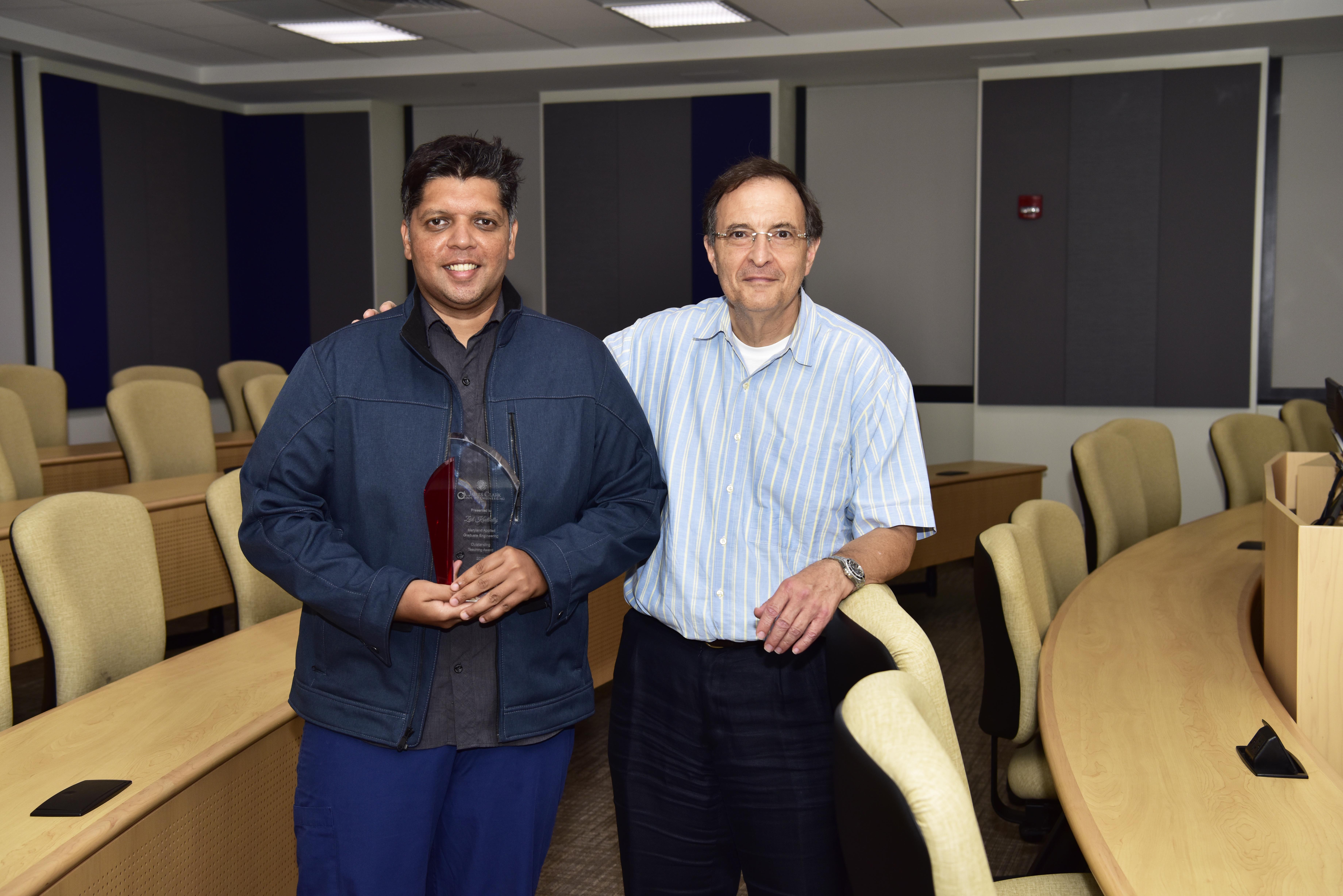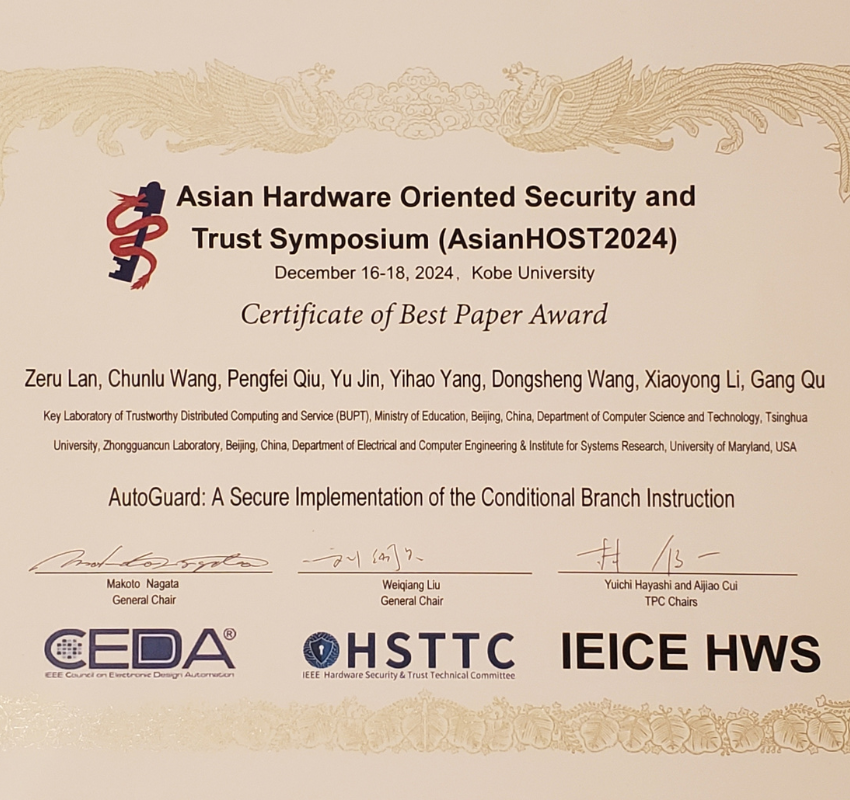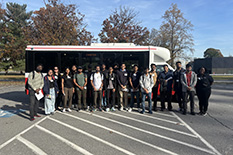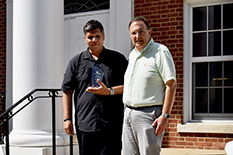News Story
Zeid Kootbally Recognized as MAGE Outstanding Teaching Award Winner for 2021-2022

Assistant Dean for Continuing Education George Syrmos presented the Outstanding Teaching Award to Zeid Kootbally on July 27, 2022 in the J.M. Patterson Building at the University of Maryland
Maryland Applied Graduate Engineering is pleased to announce Zeid Kootbally as the recipient of the MAGE Outstanding Teaching Award for the Academic Year 2021-2022.
Assistant Dean for Continuing Education George Syrmos presented the award to Kootbally on July 27, 2022 in the J.M. Patterson Building at the University of Maryland. In recognition of his contributions to MAGE students in the form of his exceptional teaching, Kootbally will also receive a cash prize.
Kootbally received his Ph.D in Computer Science from the University of Burgundy, France, in 2008 with his dissertation titled, "Moving Object Predictions in Dynamic Environments for Autonomous Ground Vehicles.” Outside of his teaching duties at MAGE, Kootbally is a Senior Research Associate with the Department of Aerospace and Mechanical Engineering at the University of Southern California (USC) and an Associate in the Intelligent Systems Division at the National Institute of Standards and Technology (NIST), where he recently accepted the NIST Distinguished Associate Award for "Developing an innovative simulation-based robot agility competition that has spurred breakthrough solutions to industry's robotic challenges." Kootbally’s current research interests are in automated robotic systems, specifically in the area of agile robotic systems. The goal of agile robotic systems is to make industrial robots smarter so they can be faster tasked/retasked and overcome unpredicted situations.
Kootbally began teaching with MAGE in 2018 when he was invited to co-teach ENPM663: Building a Manufacturing Robotic Software System (formerly known as ENPM809B) by Craig Schlenoff, who was also working at NIST.
“After seeing how much students could accomplish at the end of the first semester we taught the course, I decided to keep providing the necessary knowledge they will need in their careers,” Kootbally says.
“Professor Zeid is kind and amicable and is always ready to help us out. His classes are fun and easy to understand. My knowledge in robotics has widened after taking his class.”
Chris Neil D Souza
Kootbally now teaches ENPM809E: Python Applications for Robotics and ENPM809Y: Introductory Robot Programming in addition to ENPM663, which all use Robot Operating System (ROS) and expand on building robot software. “ENPM809E teaches Python and its applications to mobile and industrial robotics using ROS. ENPM809Y teaches modern C++ and its applications to mobile and industrial robotics using ROS. ENPM663 looks at the components of manufacturing robots, including architectures, planning/control, simulation, and measurement science. ENPM663 utilizes the Agile Robotics for Industrial Automation Competition (ARIAC), developed by NIST, as a use case. The final projects for these courses come in the form of a software which is run live at the end of the semesters.”
As for his students, Kootbally says, “I just hope the students see me as a teacher who cares about them.” He is attentive to their questions and any issues or concerns they have throughout the semester, noting that “MAGE students are very passionate and very respectful with a great desire to have real-world application experience.”
Student Chris Neil D Souza, who took ENPM809E with Kootbally in Summer 2022, certainly felt the consideration that Kootbally strove to give to each student, saying, “Professor Zeid is kind and amicable and is always ready to help us out. His classes are fun and easy to understand. My knowledge in robotics has widened after taking his class.”
Kootbally credits his teaching success, in part, to MAGE staff. “They provide great feedback, they are very responsive, and they always support both students and teachers. Whenever I promote MAGE programs I always mention the quality of the work the staff is providing,” he says.
For the future, Kootbally is looking forward to an exciting new autonomous robot project at NIST. On-road autonomous vehicles are expected to significantly influence key aspects of everyday life. However, these complex systems can pose a safety risk in the event of unexpected system performance. NIST is working on the development of standards and performance metrics to measure many aspects of autonomous vehicles.
As for teaching, he would love to incorporate some of the state-of-the-art robots available on-campus into his coursework since so much of his teaching relies on simulations and simulated robots.
Published August 15, 2022






